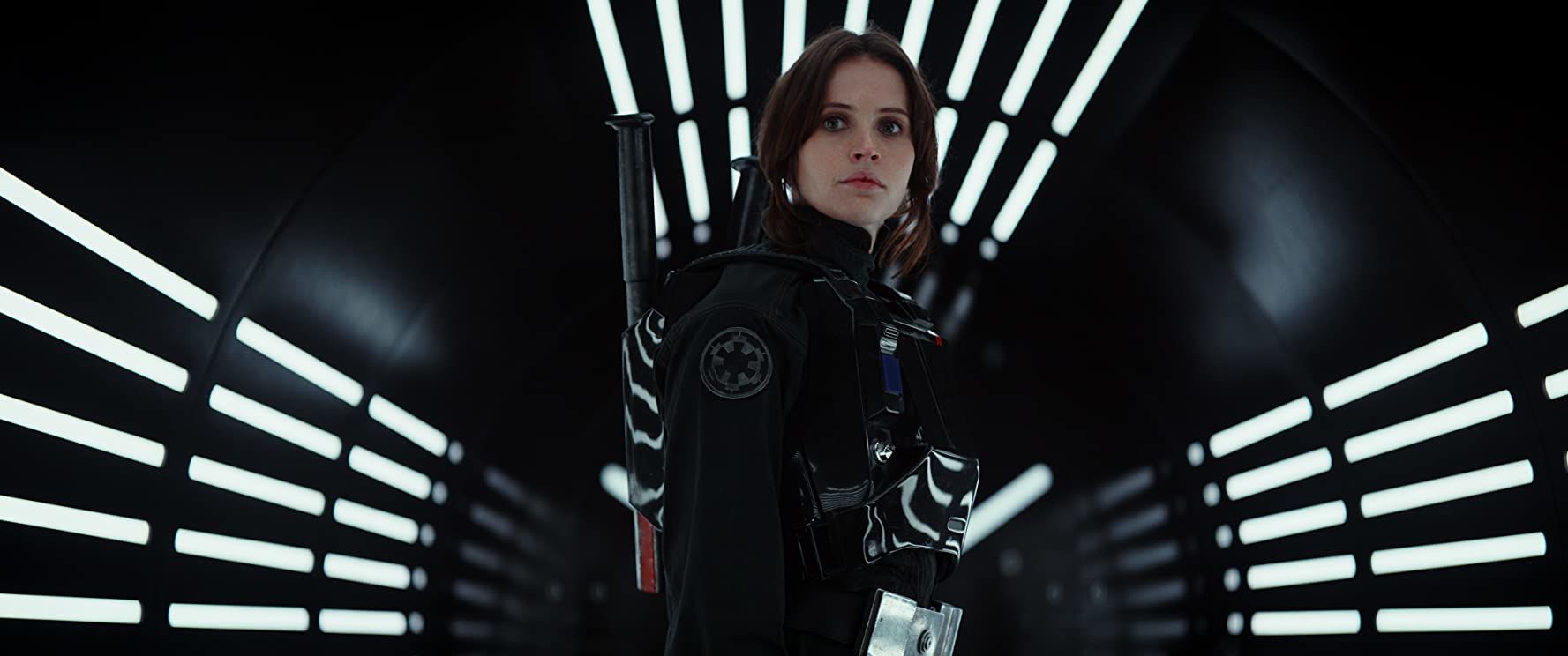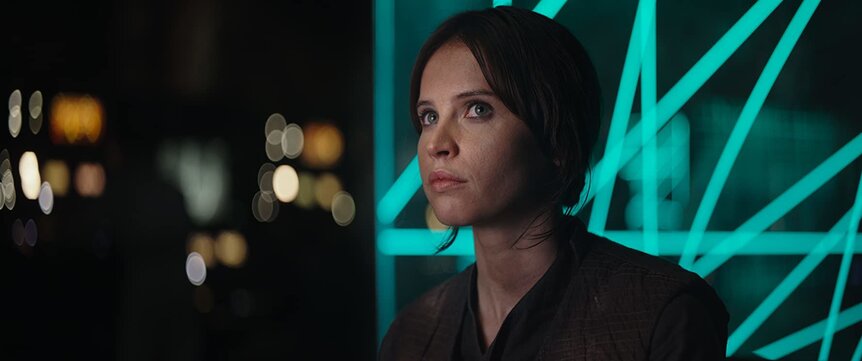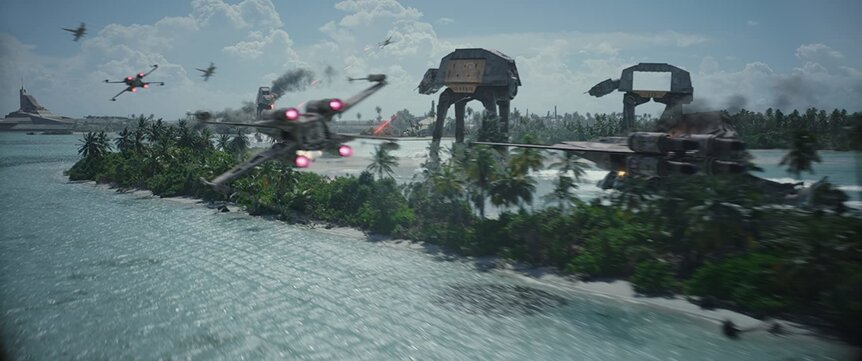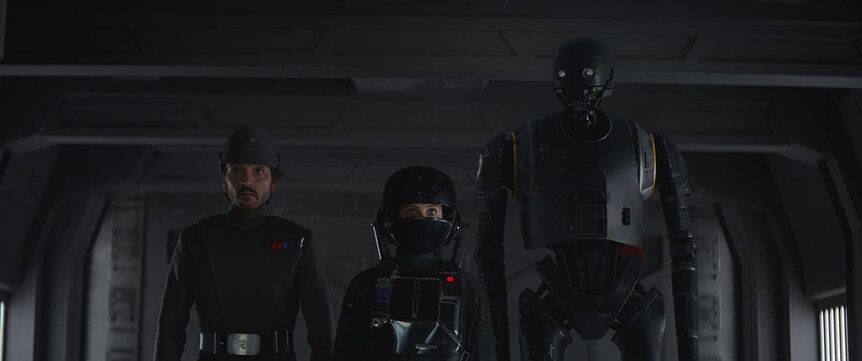Create a free profile to get unlimited access to exclusive videos, sweepstakes, and more!
Axed titles and Starbucks mix-ups: Rogue One scribes recount tales from Star Wars spinoff

When it first hit theaters in December 2016, Gareth Edwards' Rogue One was something of an unknown quantity. As the first live-action Star Wars movie to tell a story outside of the larger Skywalker Saga, it had a lot to prove. But boy, did it shatter our expectations like the Holdo Maneuver shatters First Order Star Destroyers.
Set mere days before the opening minutes of A New Hope, the film explains how the Rebel Alliance got their hands on the Empire's Death Star schematics. To that end, it also answers a long-debated question of why an important weapon like that would contain such an egregious flaw in its design.
From the final battle on Scarif, to K-2SO's sass, to Vader's hallway rampage, Rogue One is a true masterpiece, a gritty war epic worthy of that most oxymoronic of descriptions: "modern classic." It finds that rare sweet spot between filling gaps in the lore while introducing memorable characters at the same time. Indeed, one of those characters — Diego Luna's Rebel agent Cassian Andor — is getting his very own spinoff series on Disney+.
More than four years after its initial release, the movie still has stories to tell. Thanks to a recent live-watch with two of the project's screenwriters, Gary Whitta and Chris Weitz, we now have an even better understanding of a Star Wars flick that set out to and succeeded in breaking the mold.
We'll try not to choke on our aspirations as we present the coolest behind-the-scenes stories, tidbits, and unused ideas revealed to the world by Whitta and Weitz.
Opening crawl (or lack thereof)
While Rogue One does give us the classic opening line of "A long time ago in a galaxy far, far away...," it does not include an opening crawl of iconic yellow lettering against a star-strewn background. However, Whitta did actually write "more than one" opening crawl.
"You'll never see it," he said.
Later in the viewing, there was a discussion about prospective titles that didn't make the cut. Dark Times; Shadow of the Death Star; and Star Wars: Rebellion were among the names that were kicked around, but not used.
"It occurred to me that one of the ways we could differentiate this movie from the rest was if we had a title that was only one word or two words long," Whitta explained. "Even from the title of the movie, you know this isn't something that necessarily conforms to the unwritten rules of the Saga film[s]."
Even when "Rogue One" became the winning title, its incorporation into the story was going to be a little different. In Whitta's draft, Jyn Erso (Felicity Jones) was able to convince the Rebels to mount an attack on Scarif, which meant that her ship's call signal was more official than the improvisational one Bodhi (Riz Ahmed) comes up with in the finished product.
What's in a name?
Scarif, the planet that plays host to the movie's climax, got its name from a classic name mix-up at Starbucks. Whitta recounted how Gareth Edwards' prominent British accent caused a barista to mishear the phrase "it's Gareth" as "Scarif."
The tropical nature of the planet was two-fold. For one thing, it was meant to give fans something new in the Star Wars canon, as there had never been beaches in the galaxy before. For another, Scarif was meant to evoke a "Vietnam, Far East" vibe, Whitta said, because Rogue One drew inspiration from war movies like Apocalypse Now.
And the "silly names" didn't end with Scarif. For example, Malbus, the surname of Baze Malbus (Jiang Wen), the gun-toting protector of Chirrut Îmwe (Donnie Yen), was Weitz's "half-elven" Dungeons & Dragons character name from when he "was about 11."
Going to war...movies
As mentioned above, Rogue One draws more inspiration from classic war movies than it does from previous Star Wars films.
Just as Scarif was a stand-in for Vietnam, Jyn and Cassian's mission to find the renegade Saw Gerrera (Forest Whitaker) was meant to echo Captain Willard's directive to find and kill the unhinged Captain Kurtz in Apocalypse Now.
Krennic's visit to Galen Erso (Mads Mikkelsen) on Lah'mu at the very start of the film was a nod to the opening of Inglourious Basterds where Nazi Hans Landa (Christoph Waltz) interrogates a French farmer (Denis Ménochet) who is known to be harboring Jews.
"It's actually one of the more direct, cinematic influences in the film," Whitta said. "I'm surprised more people didn't pick up on it."
That Holocaust parallel was reinforced in an earlier draft, which depicted Jyn's mother as a Jedi in hiding.
And then, of course, the production looked to a bunch of classic "men on a mission" WWII flicks like The Guns of Navarone (1961), The Dirty Dozen (1967), Where Eagles Dare (1968). Those three really came into play for the third act when a group of ragtag group of misfits and rebels (within rebels) infiltrate an enemy base while dressed as the opposition.
"All the stuff where they put on the Imperial uniforms and infiltrate Scarif ... is all directly from movies like that where you'd have all these great actors from the '60s and '70s dressing up like Nazis to infiltrate Nazi bases," Whitta said.
Cassian's consternation
In an earlier draft of the screenplay, Cassian Andor was a double agent for the Empire. According to Weitz, he only joined the bad guys to use their resources as a way to get revenge on Saw Gerrera for killing his loved ones. Cassian was then going to completely switch sides when he saw the Death Star and realized how far the Empire was willing to go for power. The third act in that version saw him gaining the trust of a wary Jyn.
Speaking of Jyn, she once had an interaction with Bor Gullet, the tentacled, mind-reading alien used by Saw to glean the truth out of his captives. Created by Weitz, the character was envisioned as "a space Hannibal Lector" who "delights in traumatic memories." Weitz explained that a scene of Jyn trading some of her negative memories to Bor Gullet in exchange for information was cut from the movie.
Elswhere, Grand Moff Tarkin wasn't always meant to have such a large role in the film. While Peter Cushing was no longer alive to play the character, Tarkin still needed to appear in order to maintain continuity. To give ILM a little more leeway, Whitta wrote Tarkin as being hidden in shadow with limited dialogue. In the end, Cushing was pretty much brought back to life with Guy Henry providing a commendable impersonation through body movement and line delivery.
Oh, and you know Admiral Raddus, the dude who kind of looks like Admiral Ackbar? Well, he's was born out of a desire to not over-use Ackbar. Instead, Edwards asked for "a Mon Calamari that looks like Winston Churchill," Whitta said.






























